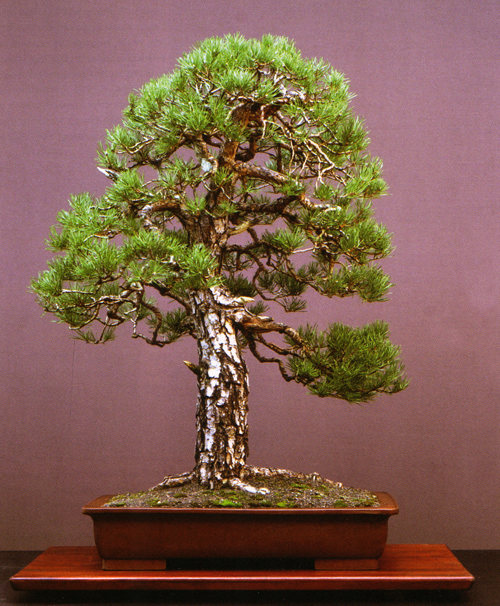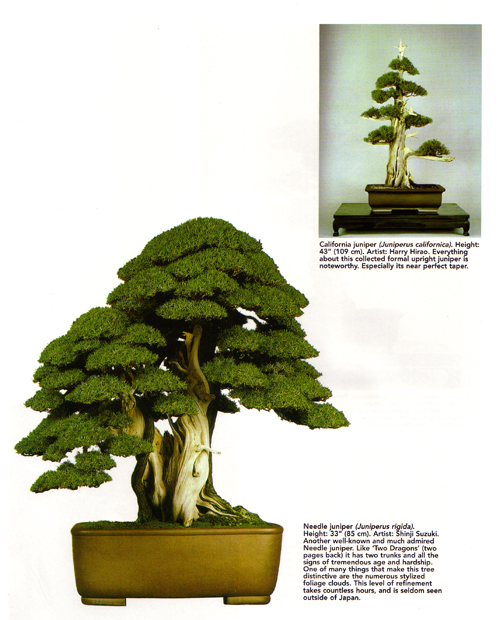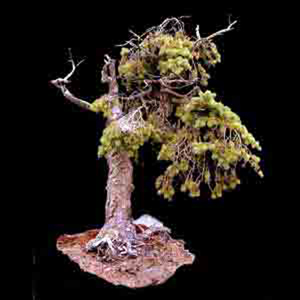
This Scot’s pine (Pinus sylvestris) by Walter Pall is from the cover of Bonsai Today issue 104. It was presented by Walter as an example of a naturalistic bonsai.
“… too many of these bonsai look like they are made of plastic…”
The whole quote, which was written by Walter Pall, and appears in Bonsai Today issue 104, goes like this: “I have seen that the trend in styling is toward more and more refinement, which often takes away all the naturalness. I find that too many of these bonsai look like they are made of plastic and are not real.”
You be the judge
To my eyes, Walter Pall’s Scot’s pine is a wonderful bonsai. That’s why we chose it for the cover of Bonsai Today. But we’ve also featured some much more stylized and refined trees for covers; trees that we like. Are these trees overly refined and plastic looking?

This page from our Juniper book features a Needle juniper that is famous in Japanese bonsai circles (famous enough to appear on the cover of Kindai Bonsai – Japan’s foremost bonsai magazine – and Bonsai Today issue 63). It was styled by Shinji Suzuki, Michael Hagedorn‘s teacher (Michael is an accomplish American bonsai artist. teacher and author). The California juniper in the upper corner was collected and styled by Harry Hirao, “Mr. California Juniper.”
Feel before you think?
Masahiko Kimura has commented at various times that ultimately bonsai is about feeling. I think that’s true of most things; before we think, we have a basic attraction or aversion (or indifference) to something. Then, we tend to use concepts to explain or justify what we feel. If you agree with this view (or even if you don’t), you might want to try to just look at the trees in this post, without thinking too much, and see what you feel about them.

This wild looking Big cone Douglas fir (Pseudotsuga macrocarpa) belongs to Dan Robinson, a well know American bonsai artist. Here’s what Dan has to say about it on the Elandan Gardens website: “Collected from natural granitic basin high in the Colorado Rockies, this tree, with the helping hand of Larry Jackall, was lifted straight up out of the basin using a crowbar under the bottom branch. The tree was subsequently planted in a granite basin here at Elandan Gardens. Its spiraled bark and dead wood are the result of a genetic mutation.
If want to read more of Walter Pall’s article…
Not only can Walter style great bonsai, but he can make a point in writing. Unfortunately, Bonsai Today 104, where Walter’s article appears, is out of print. But don’t despair, we’ll post quotes from it right here, as we continue to explore this and other related subjects. Meanwhile, here’s another quote to whet your appetite: “A traditional bonsai is ideal; it is abstract. A naturalistic bonsai is realistic, but never totally realistic. There’s always a certain degree of abstraction.”
…or visit his website
Walter has one of the best websites on bonsai.
Here’s our previous post on The Great Debate.
Yes, many bonsai featured in internation/national competitions and magazines look picture-perfect. Is that bad? Not necessarily, it’s in the eye of the beholder. A person like me that looks at a lot of trees in nature will immediately be turned-off by something that looks picture-perfect. Others may want a view of what perfect looks like. In the U.S., I think a true American style has not been reached, and that too many artists focus on Asian rules to produce bonsai that Americans cannot associate with. This may be part of the reason for the turn-off in at least this part of the world.
I agree some bonsai are better off with the natural look. However some do not. It’s up to the artist to decide. Walter Paul is a good artist, but in know way is he of the same leauge as Mr Kimura, Mr. kobayashi, or Sinji Sasuki. These are just a couple of great bonsai artist that go to great pains to style there trees. Again some bonsai are better off with the natural look, but imagine a black pine totaly grown out with no wire, or shimpaku with no wire. Anyways just one persons thoughts
Lance Laney
what is wrong here ? i idea is to train bonsais to be great master works , sone times you get lucky and find the perfit tree to train in to a master work which all of these are ! any one would love such trees and to see them over and over agine . and i have seen many photos of master works in japan . maybe he can not find tress to make such wonders !! john
Bonsai is an art not a science.
Many modern artists who are technically challenged, try to drag the old masters down, by critising their masterpieces.
Some junk art is highly prized and many people buy it, but Iam not one of them.
I agree with Walter. Many trees do look plastic and overly refined and not really very natural. Dan Robinson’s trees look very natural and unrefined. Of course, most of his are collected trees. Walter, too, I think, collects a lot of his trees.
For the average bonsai grower…..its impossible to collect what they have collected over the years. So, we trudge along and try to make a nursery tree look natural as a bonsai and not contrived following those published rules that so many trees reflect.
Short, triangular trees with massive trunks are a turn off to me, i.e., many Trident Maples. They ain’t natural and don’t grow that way in nature !
So many trees and so little time…………..
It’s art so however you interpret it it’s up to you. That’s what’s so great about it. A multitude of trees will breed a multitude of opinions. I like it!
I have grown bonsai for the best part of more than 20 years. I can understand both sides of the discussion but I feel that I must side with Walter as I have seen the trend in the print media clearly promote the perfect tree. (which doesn’t exist)
I do not condone this nor say that for those that feel the need to concentrate on only top award winning trees that it is right or wrong.
I will however point out that if you are really honest and think back to when we all started down the path of Bonsai, the reason we all got involved is because it is fun, relaxing and allows for an outlet to the stresses of our lives.
Not enough is promoted to follow this ideal and to encourage those who would like to be involved in the simpler basics of our chosen art/lifestyle etc.
I know that there are articles printed from time to time and thousands of books, gigabytes of data on the internet and many thousands of clubs and associations around the world, but none of this addresses the issue of fear that beginners have to getting started. Most will not join clubs etc because they are not confident to get involved, many shy away because of the need to conform to having “that perfect tree”.
My own collection is nowhere near perfect. Does not have a perfect form that I would be happy showing others but I am happy with them and they allow me to simpply potter around with them making any number of mistakes as I go.
What do I like – well trees that look like trees and not those with huge trunks for their height as well as those with too much stripped bark and white wood (jin etc) .
I am still interested in looking at them and working out how it is done but it has got to the point where it is an overkill with this and the magazines are full of it.
Perfect – maybe, if that is your interest. Me I go get my tools and get out in the garden and do my own thing.
Alan…
As far as this amatuer enthusiast is concerned Walters “naturalist” style is GREAT. Its what you expect a miniture “old” tree to look like. The more manicured & polished styles of Kimura and others is NOT what you see during a stroll in the forest…..matty
I tend to disagree with the distinction “naturalistic” bonsai. His bonsai as shown is simply great bonsai, and yes, it is art. I’ve seen other pieces Walter has done that I do not think rise to that level, and of course this is the reverse of the norm in the bonsai world. Most of Walter’s work is more than artistic, it is art. Among the masses, I’d say most of our work is artistic or not, some more and some less, and very little rises to the level of art. But stylized or not stylized, great bonsai are great art.
Thanks Chris,
Yeah, agreed labels like ‘naturalistic’ only go so far, and at some point can even become meaningless. The same with the use of the word ‘masses’ which I suspect doesn’t go very far at all.